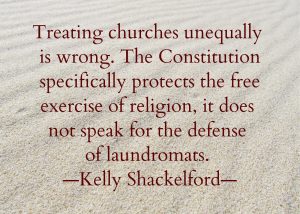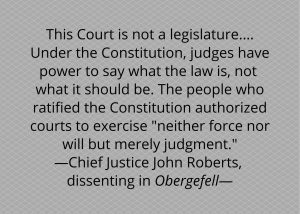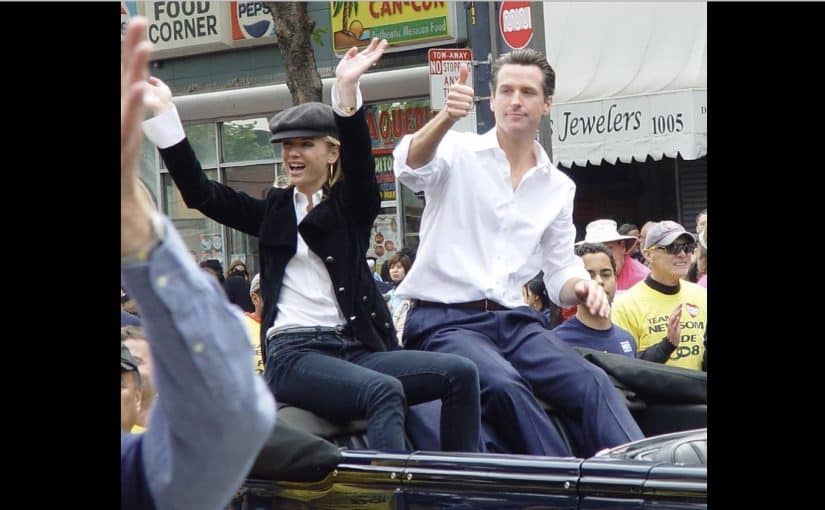A Life Site News article reports, “California’s guidelines for ‘Places of Worship and Providers of Religious Services and Cultural Ceremonies,’ issued by the state government on May 25, stated, ‘Places of worship must … limit attendance to 25% of building capacity or a maximum of 100 attendees, whichever is lower.’”
 Unfortunately, Chief Justice John Roberts sided with the 4 reliably liberal justices on the bench to produce a 5-4 ruling that upheld the state’s guidelines. Chief Justice Roberts wrote in his concurring opinion that the state’s reopening regulation “exempts or treats more leniently only dissimilar activities, such as operating grocery stores, banks, and laundromats, in which people neither congregate in large groups nor remain in close proximity for extended periods.” A PDF file of the above graphic is available here.
Unfortunately, Chief Justice John Roberts sided with the 4 reliably liberal justices on the bench to produce a 5-4 ruling that upheld the state’s guidelines. Chief Justice Roberts wrote in his concurring opinion that the state’s reopening regulation “exempts or treats more leniently only dissimilar activities, such as operating grocery stores, banks, and laundromats, in which people neither congregate in large groups nor remain in close proximity for extended periods.” A PDF file of the above graphic is available here.
Yet Kelly Shackelford of the First Liberty Institute disagreed. He said, “Treating churches unequally is wrong. The Constitution specifically protects the free exercise of religion, it does not speak for the defense of laundromats. Churches and houses of worship just want to be treated equally and trusted to adhere to proper social distancing and hygiene practices just like they do when they go about the rest of their daily lives in permitted social settings.”

A PDF file of this graphic is available here.
The guidelines had been challenged by a California church, and the case received a Supreme Court ruling May 29, 2020. Keep in mind this point from Alliance Defending Freedom’s Ryan Tucker, who said,” The church in this case—and, indeed, the vast majority of churches—agreed to abide by the same social distancing and hygiene standards set for others. The church simply asked to be treated the same as comparable secular businesses, which is the bare minimum that the First Amendment’s free exercise clause requires. The court’s opinion is not the final word on the issue. We fully expect other cases where our fundamental freedoms are at stake to make their way back to the Supreme Court on a more fully developed record.”
The Fresno Bee reported that one church in downtown Fresno—Cornerstone Church—defied the order, even though the church took great care to implement strict social distancing guidelines. It opened its doors to 350 people on Sunday, May 31, in each of two services. That number represents about 25 percent of the capacity of the theatre in which it meets.
 Justice Roberts knows better than to rule as he did. In Obergefell v. Hodges, the ruling that authorized same-sex marriage nationwide, Justice Roberts said this in his dissenting opinion: “[T]his Court is not a legislature. Whether same-sex marriage is a good idea should be of no concern to us. Under the Constitution, judges have power to say what the law is, not what it should be. The people who ratified the Constitution authorized courts to exercise ‘neither force nor will but merely judgment.'” A PDF file of the above graphic is available here.
Justice Roberts knows better than to rule as he did. In Obergefell v. Hodges, the ruling that authorized same-sex marriage nationwide, Justice Roberts said this in his dissenting opinion: “[T]his Court is not a legislature. Whether same-sex marriage is a good idea should be of no concern to us. Under the Constitution, judges have power to say what the law is, not what it should be. The people who ratified the Constitution authorized courts to exercise ‘neither force nor will but merely judgment.'” A PDF file of the above graphic is available here.
Yet Roberts is and was all too content with allowing the governor of California to make arbitrary laws in this case (he’s not a legislator, either), and with engaging in his own form of lawmaking when he upheld Governor Newsom’s policy.
Copyright © 2020 by B. Nathaniel Sullivan. All rights reserved.
top image credit: California Governor Gavin Newsom is a former mayor of San Francisco and a former California Lieutenant Governor. The above image is of him and then-fiancée Jennifer Siebel at the 2008 San Francisco Pride parade.
Additional pertinent information:
In an article published at The Hill titled “It wasn’t just religious liberty that Chief Justice Roberts strangled,” former federal prosecutor Andrew C. McCarthy analyzed Roberts’s participation in the majority opinion and the implications it has beyond those related to religious liberty..
Here is a portion of the Chief Justice’s opinion.
“Our Constitution principally entrusts the safety and the health of the people to the politically accountable officials of the States to guard and protect. … When those officials undertake to act in areas fraught with medical and scientific uncertainties, their latitude must be especially broad. Where those broad limits are not exceeded, they should not be subject to second-guessing by an unelected federal judiciary, which lacks the background, competence, and expertise to assess public health and is not accountable to the people.”
Here are Andrew McCarthy’s three concluding paragraphs.
The Justice Department may think the economy-crashing restrictions imposed by blue-state governors are irrational. By the chief justice’s lights, though, it “seems quite improbable” that the Supreme Court would find unconstitutional the actions of state and local officials wrestling with “a novel severe acute respiratory illness” which has “killed … more 100,000 people nationwide,” and as to which “there is no known cure, no effective treatment, and no vaccine.”
There is no recognition, in Roberts’ rendering, that there is another side to this equation — a side where 400 times the number of people who’ve died have lost their jobs, millions of them facing ruin. The stubborn message: Don’t expect the court to help you, you’re the ones who elected these people; if you don’t like what they do, un-elect them. If you’ve elected social engineers who say the Bill of Rights is above their pay grade, that’s your problem.
The justices are happy to order that abortion must be available, to decide which couples (or perhaps throuples) must be permitted to marry, and to dictate what’s ever next in the ceaseless march of progressive, organic “liberty.” But as for the liberties that are actually in the Constitution, we are on our own.
Copyright © 2020 by B. Nathaniel Sullivan. All rights reserved.
